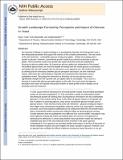Growth landscape formed by perception and import of glucose in yeast
Author(s)
Youk, Hyun; van Oudenaarden, Alexander
Downloadvan Oudenaarden_Growth landscape.pdf (1.837Mb)
OPEN_ACCESS_POLICY
Open Access Policy
Creative Commons Attribution-Noncommercial-Share Alike
Terms of use
Metadata
Show full item recordAbstract
An important challenge in systems biology is to quantitatively describe microbial growth using a few measurable parameters that capture the essence of this complex phenomenon. Two key events at the cell membrane—extracellular glucose sensing and uptake—initiate the budding yeast’s growth on glucose. However, conventional growth models focus almost exclusively on glucose uptake. Here we present results from growth-rate experiments that cannot be explained by focusing on glucose uptake alone. By imposing a glucose uptake rate independent of the sensed extracellular glucose level, we show that despite increasing both the sensed glucose concentration and uptake rate, the cell’s growth rate can decrease or even approach zero. We resolve this puzzle by showing that the interaction between glucose perception and import, not their individual actions, determines the central features of growth, and characterize this interaction using a quantitative model. Disrupting this interaction by knocking out two key glucose sensors significantly changes the cell’s growth rate, yet uptake rates are unchanged. This is due to a decrease in burden that glucose perception places on the cells. Our work shows that glucose perception and import are separate and pivotal modules of yeast growth, the interaction of which can be precisely tuned and measured.
Date issued
2009-12Department
Massachusetts Institute of Technology. Department of Biology; Massachusetts Institute of Technology. Department of PhysicsJournal
Nature
Publisher
Nature Publishing Group
Citation
Youk, Hyun, and Alexander van Oudenaarden. “Growth Landscape Formed by Perception and Import of Glucose in Yeast.” Nature 462.7275 (2009): 875–879.
Version: Author's final manuscript
ISSN
0028-0836
1476-4687